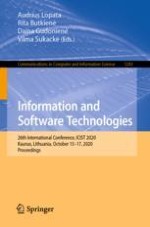2020 | Book
Information and Software Technologies
26th International Conference, ICIST 2020, Kaunas, Lithuania, October 15–17, 2020, Proceedings
Editors: Audrius Lopata, Rita Butkienė, Daina Gudonienė, Vilma Sukackė
Publisher: Springer International Publishing
Book Series : Communications in Computer and Information Science
